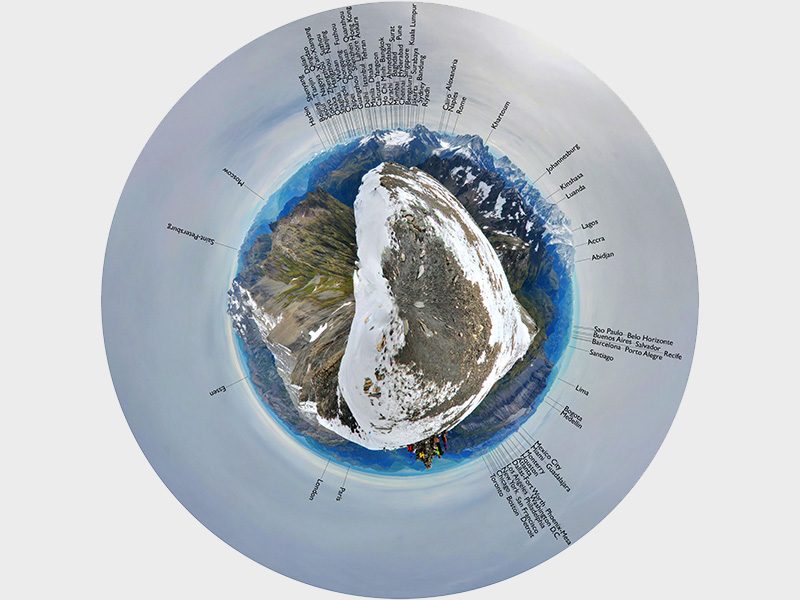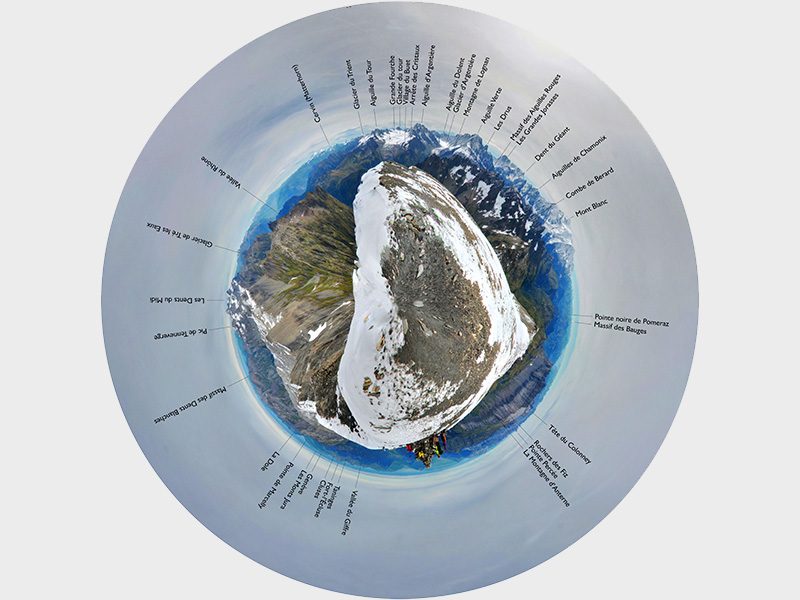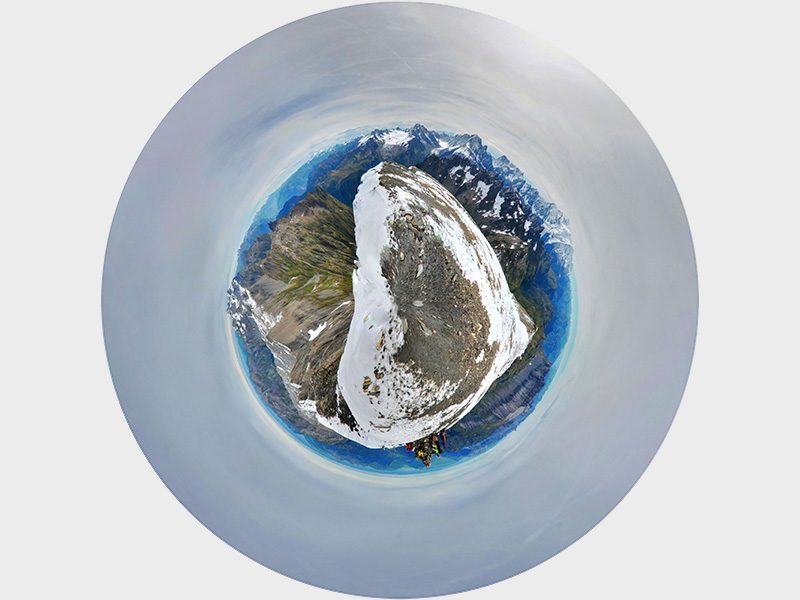[Winter 2014]
[See also the presentation of the work on page 68 – Luc Courchesne, L’INVENTION DE L’HORIZON – for Phyllis Lambert]
AN INTERVIEW BY JACQUES DOYON
Jacques Doyon: For the Sitegeist fund-raising campaign initiated by Ciel variable, you produced an artwork called L’invention de l’horizon, based on a drawing that you found ten years ago and in which you recognized a strong affinity with your own research. Can you describe how that drawing became interwoven with your work and the form in which it was finally brought to life?
Luc Courchesne: After I made the interactive video panorama Paysage no. 1 (1997), I began to look for a way to simplify the shooting and presentation of immersive artworks. My hypothesis was that I could replace the cumbersome mechanism of four synchronized cameras with a device using a single camera. After a number of attempts, in the summer of 1998 I tested a successful concept using a pyramidal mirror that reflected a complete horizon, divided into four portions, into a camera placed below. To project the image, one simply replaced the camera with a projector and placed the projector-mirror device in the centre of a cylindrical screen. As I became involved in making an optical-quality pyramidal mirror, I discovered the work of Professor S. K. Nayar, at Columbia University in New York, who had developed a catadioptric (conico-spherical) mirror that, attached to a surveillance camera, recorded the space around it in its entirety. When I saw this circular anamorphosis, I had the idea of replacing the cylindrical screen with an inverted dome on which the visual coherence of the place would be restored for a viewer situated in the centre. Following in Nayar’s footsteps, I discovered the existence of Cyclovision Technologies, a company that was manufacturing and marketing his technology under licence. I was therefore able to get my hands on an early sample of the optical device in the fall of 1999 and, with the help of an engineer at the company, Sergey Trubko, I adapted it to the new HD video cameras, which were just coming on the market at the time. The Panoscope prototype, a single-channel immersive projection device, was presented publicly for the first time at the SIGGRAPH conference in New Orleans in July 2000.
In Stephan Oetterman’s book on the history of the panorama, which had been recommended to me by Erkki Huhtamo of UCLA soon after, I saw for the first time the drawing conceived by Horace-Bénédict de Saussure and made by Marc-Théodore Bourrit in 1776. The formulation of the drawing was exactly the same as the images that I was making for the Panoscope, and I immediately made plans to return to the site of de Saussure’s brilliant intuition: to place the viewer in the centre of the drawing by tracing everything that can be seen on the horizon around him. The opportunity to climb the Buet was finally offered to me in the context of Ciel variable’s Sitegeist project in 2013. Having been chosen by Phyllis Lambert to create an original artwork, I felt that I would have to propose an essential project to her. The idea of producing a photographic panorama at the summit of the Buet, the very place where the horizon was invented, immediately excited her.
JD: The Sitegeist project is based on the idea of an encounter with a collector. What was at play in this encounter, and how did the adventure of taking a picture in the Alps actually happen?
LC: We agreed right away to go there together, and, coordinating our agendas, we chose the week of 9 to 16 September 2013. Ms. Lambert met me in Geneva, and we spent a few days at the modest Hôtel du Buet to acclimatize ourselves to the mountain air and explore the region before I undertook the actual climb and she made her way back to Geneva and Montreal. That’s exactly what happened. Given my lack of knowledge and training, I had taken the precaution of asking two experienced mountain climbers to accompany us. We met up with Lili and Claude Guichard, the retired parents of two of my former students, and began our alpine stay with a hike along the admirable Chemin de Bisse that leads from the Col de la Forclaz, to the Swiss border, to the foot of the Trient glacier. The peak of the Buet isn’t visible from the village of Vallorcine, where Hôtel du Buet is situated, and so, to symbolically begin the ascent in her company, I met with Ms. Lambert the evening before on the path leading to the Refuge de la Pierre à Bérard, from which the peak is in view and accessible. A high-altitude snowfall forced a delay in my departure for the summit by one day, and I began the climb toward the Refuge with my guides on Friday, 13 September. In the early morning on Saturday the 14th we left the Refuge for the summit, which we reached around noon. The sky was clear and the view was splendid. It took only an hour to take the photographs and appreciate the breathtaking horizon that had inspired de Saussure exactly 237 years before.
In the early morning on Saturday the 14th we left the Refuge for the summit, which we reached around noon. The sky was clear and the view was splendid. It took only an hour to take the photographs . . . .
JD: What are the outcomes of this project for you? Did the production of L’invention de l’horizon and the encounter with Phyllis Lambert open up new perspectives in your research and creation?
LC: I have the feeling that this photographic excursion to the summit of the Buet enabled me to close a loop that had opened sixteen years before with the plan to highlight the creation of conclusive immersive experiences by trying to simplify the creation and presentation of works placing the observer at the centre of what can be seen. Since then, the Panoscope has developed to become a platform for creation and dissemination; the immersive dome of the Société des arts technologiques has been created and hosts cohorts of digital artists who bring to light their own forms of expression and meet their publics; finally, the photographic journal, which began with the discovery of Professor Nayar’s optical system and takes up the anamorphic principle invented by de Saussure, is being radically transformed with the multiplication of spherical and 3D capture devices that are coming out. In my immersive photography practice, I have now dropped static points of observation and am shifting toward the experience of an open space in which the observer, who becomes a visitor or even inhabitant, frames his or her own visual field in real time.
I am particularly thrilled to have been accompanied inspired by Ms. Lambert in this exercise of returning to sources. The Sitegeist project brought out our common interest in the eighteenth century and the great transformations that continue to inform our actions. Like her, I like the idea that old traces hidden in contemporary expression add to the transformative power of an artwork. It’s not out of the question to think that the experience of immersion and participatory cultures typical of our era find their sources in the drawing by Horace-Bénédict de Saussure that has, to put it simply, reframed the observer’s position in the centre of his or her subjective experience of the world and become, in a way, the kernel of the modern subject. De Saussure thus invented the horizon, which seems today to be closing in around us at the same time as it is opening up to worlds of which he could not have even suspected the existence.
Luc Courchesne is a digital arts pioneer. From interactive portraits to immersive experience systems, he has created innovative and engaging works that have earned him prestigious awards such as the Grand Prize of the ICC Biennale in Tokyo in 1997 and the Award of Distinction at Ars Electronica in Linz, Austria, in 1999. His works are in major collections, including the ZKM Karlsruhe collection, and have featured in a hundred exhibitions around the world, including at the Museum of Modern Art in New York. He is the director of research at the Société des arts technologiques (SAT), an honorary professor at the Université de Montréal, and member of the Royal Canadian Academy of Arts. Courchesne is represented by Galerie Pierre-François Ouellette art contemporain. courchel.net
Jacques Doyon has been the editor-in-chief and director of Ciel variable since January 2000.
—
Related Links
Éric Clément, L’Horizon d’une rencontre, La Presse, Édition du 1 février 2014, section ARTS, écran 17. In French.Luc Courchesne, L’Invention de l’Horizon, video, 2016. In French.




